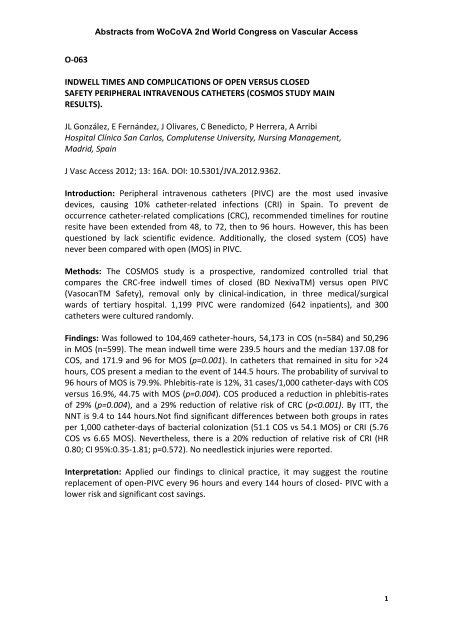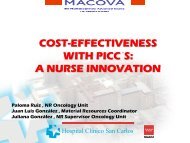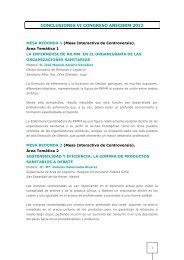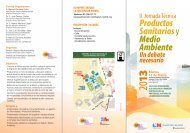o-063 indwell times and complications of open versus closed safety ...
o-063 indwell times and complications of open versus closed safety ...
o-063 indwell times and complications of open versus closed safety ...
You also want an ePaper? Increase the reach of your titles
YUMPU automatically turns print PDFs into web optimized ePapers that Google loves.
Abstracts from WoCoVA 2nd World Congress on Vascular Access<br />
O-<strong>063</strong><br />
INDWELL TIMES AND COMPLICATIONS OF OPEN VERSUS CLOSED<br />
SAFETY PERIPHERAL INTRAVENOUS CATHETERS (COSMOS STUDY MAIN<br />
RESULTS).<br />
JL González, E Fernández, J Olivares, C Benedicto, P Herrera, A Arribi<br />
Hospital Clínico San Carlos, Complutense University, Nursing Management,<br />
Madrid, Spain<br />
J Vasc Access 2012; 13: 16A. DOI: 10.5301/JVA.2012.9362.<br />
Introduction: Peripheral intravenous catheters (PIVC) are the most used invasive<br />
devices, causing 10% catheter-related infections (CRI) in Spain. To prevent de<br />
occurrence catheter-related <strong>complications</strong> (CRC), recommended timelines for routine<br />
resite have been extended from 48, to 72, then to 96 hours. However, this has been<br />
questioned by lack scientific evidence. Additionally, the <strong>closed</strong> system (COS) have<br />
never been compared with <strong>open</strong> (MOS) in PIVC.<br />
Methods: The COSMOS study is a prospective, r<strong>and</strong>omized controlled trial that<br />
compares the CRC-free <strong>indwell</strong> <strong>times</strong> <strong>of</strong> <strong>closed</strong> (BD NexivaTM) <strong>versus</strong> <strong>open</strong> PIVC<br />
(VasocanTM Safety), removal only by clinical-indication, in three medical/surgical<br />
wards <strong>of</strong> tertiary hospital. 1,199 PIVC were r<strong>and</strong>omized (642 inpatients), <strong>and</strong> 300<br />
catheters were cultured r<strong>and</strong>omly.<br />
Findings: Was followed to 104,469 catheter-hours, 54,173 in COS (n=584) <strong>and</strong> 50,296<br />
in MOS (n=599). The mean <strong>indwell</strong> time were 239.5 hours <strong>and</strong> the median 137.08 for<br />
COS, <strong>and</strong> 171.9 <strong>and</strong> 96 for MOS (p=0.001). In catheters that remained in situ for >24<br />
hours, COS present a median to the event <strong>of</strong> 144.5 hours. The probability <strong>of</strong> survival to<br />
96 hours <strong>of</strong> MOS is 79.9%. Phlebitis-rate is 12%, 31 cases/1,000 catheter-days with COS<br />
<strong>versus</strong> 16.9%, 44.75 with MOS (p=0.004). COS produced a reduction in phlebitis-rates<br />
<strong>of</strong> 29% (p=0.004), <strong>and</strong> a 29% reduction <strong>of</strong> relative risk <strong>of</strong> CRC (p
Abstracts from WoCoVA 2nd World Congress on Vascular Access<br />
2
Abstracts from WoCoVA 2nd World Congress on Vascular Access<br />
3





